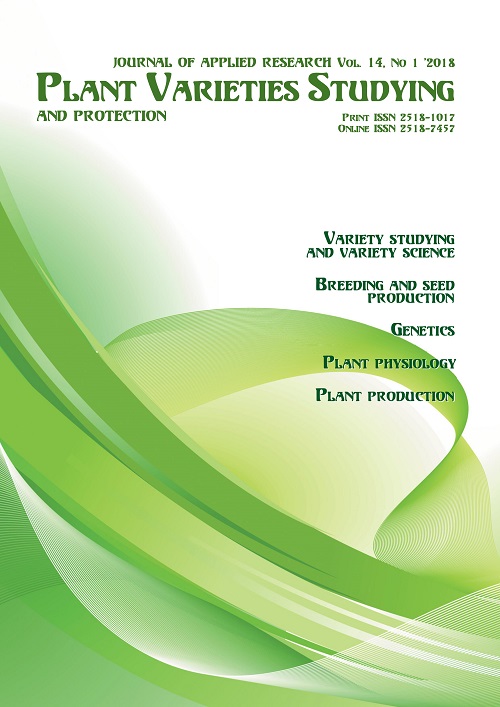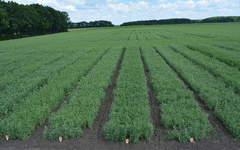Seasonal development of the genus <i>Heuchera</i> L. plant varieties in the conditions of the Right-coast Forest-Steppe of Ukraine
DOI:
https://doi.org/10.21498/2518-1017.14.1.2018.126485Keywords:
Heuchera L., variety, budding, florescence, fruiting, vegetationAbstract
Purpose. To study the seasonal cycle of development for introduced genus Heuchera L. plant varieties.
Methods. Phenological, biometrical and analytical.
Results. Based on the results of phenological observations, it was marked that the plants of Heuchera genus of the Right-coast Forest-Steppe of Ukraine pass through the all stages of seasonal development cycle. It was revealed that the phases of green shoots growing and blossoming are considerably prolonged. The phases of budding, blossoming and fruiting take place simultaneously. The studied plants, according to the nature of the development rhythm, are classified as a phenological “summer-winter green” type with winter dormancy, which determines the duration of their “decorativeness”.
Conclusions. It was found out that the vegetation period for Heuchera species lasts 216–232 days. The beginning (I–II decade of May), duration (26–43 days) of the blossoming phase and phenological spectra analysis of the genus Heuchera varieties show that the rhythm of their development responds to the climatic conditions of the Right-coast Forest-Steppe of Ukraine. The decorativeness of introduced Heuchera varieties is evident from the budding to the end of the vegetation. So, they are able to provide a long decorative effect from March to early November according to different types of planting. As the fruiting phase is available, including the fruit-setting and viable seeds ripening, it is an absolute argument for selection work fulfillment.
Downloads
References
Lapin, P. I., & Sidneva, S. V. (1968). Assessment of plant introduction potentials based on phenological facts. Byuleten Glavnogo botanicheskogo sada AN SSSR [Bulletin of the Main Botanical Garden of the USSR Academy of Sciences], 69, 14–21. [in Russian]
Poplavskaya, G. I. (1948). Ekologiya rasteniy [Ecology of plants]. Moscow: Sovetskaya nauka. [in Russian]
Serebryakov, I. G. (1964). Comparative analysis of some rhythm indexes of plant seasonal development at various botanical and geographical zones of the USSR. Byulleten Moskovskogo obshchestva ispytateley prirody. Otdel biologicheskiy [Bulletin of the Moscow Society of Naturalists. Department of Biology], 69(5), 72–89. [in Russian]
Voroshilov, V. N. (1960). Ritm razvitiya u rasteniy [Plant development rhythm]. Moscow: Izd-vo AN SSSR. [in Russian]
Krokhmal, I. I., & Kryazh, N. A. (2009). The introduction success of ornamental shadow and shade-tolerant herbaceous perennials from Donetsk Botanical Garden collection (NAS of Ukraine) in accordance to their phenorhytmotype. Byuleten Nikitskogo botanicheskogo sada [Bulletin of the State Nikitsky Botanical Gardens], 99, 13–17. [in Russian]
Lapin, P. I. (1974). The importance of plant life-rhythm study for introduction. Byuleten Glavnogo botanicheskogo sada AN SSSR [Bulletin of the Main Botanical Garden of the USSR Academy of Sciences], 91, 3–8. [in Russian]
Pel’tikhina, R. I., & Krokhmal, I. I. (2005). Introduktsiya vidov i sortov roda Hemerocallis L. (Hemerokallidaceae R. Br.) v Donbass i perspektivy ikh ispol’zovaniya v dekorativnom sadovodstve [The introduction of species and varieties of the genus Hemerocallis L. (Hemerokallidaceae R. Br.) at Donbas and their practical use in ornamental horticulture]. Donetsk: Nord-Press. [in Russian]
Fomina, T. I. (2012). Biological features of the wintergreen polycarpic plants in the Forest-Steppe zone of Western Siberia. Vestnik Tomskogo Gosudarstvennogo Universiteta. Biologiya [Tomsk State University Journal of Biology], 1, 43–51. [in Russian]
Radionova, E. S. (2003). Rastitel’nyy pokrov Severnoy Ameriki kak istochnik introduktsii dekorativnykh mnogoletnikov v Sredney polose Rossii [Plant cover of the North America as a source for ornamental perennials introduction in the Central Russia] (Extended Abstract of Cand. Biol. Sci. Diss. (Botany). N. V. Tsitsin Main Botanical Garden, Moscow, Russia. [in Russian]
Reut, A. A., & Mironova, L. N. (2014). Introduction and seed reproduction of the genus Heuchera L. representatives in Bashkortostan. In Likarske roslynnytstvo: vid mynuloho do novitnikh tekhnolohii: materialy III Mizhnarodnoi naukovo-praktychnoi internet-konferentsii [Medicinal plant growing: from the past to the latest technologies: materials of the III Int. Scientific and Practical Internet Conf.] (pp. 66–67). May 15–16, 2014, Poltava, Ukraine. [in Ukrainian]
Selezneva, A. A, Stepanov, M. V., & Egorova, O. A. (2009). The introduction of some hejhera species (Heuchera) in Saratov city. Bûlletenn´ Botani?českogo Sada Saratovskogo Gosudarstvennogo Universiteta [Bulletin of Botanic garden of Saratov State University], 8, 175–178. [in Russian]
Andrukh, N. A. (2017). Criteria of assessing introduced varieties of the genus Heuchera L. Plant Varieties Studying and Protection, 13(1), 55–63. doi: 10.21498/2518-1017.13.1.2017.97260. [in Ukrainian]
Karpisonova, R. A. (1972). Methods of phenological observations for herbaceous perennials at the Flora Division of the Main Botanical Garden of the Academy of Sciences of the USSR. In P. I. Lapin (Ed.), Metodika fenologicheskikh nablyudeniy v botanicheskikh sadakh SSSR [Methods of phenological observations in the botanical gardens of the USSR] (pp. 47–53). Moscow: N.p. [in Russian]
Zaytsev, G. N. (1978). Fenologiya travyanistykh mnogoletnikov [Phenology of herbaceous perennials]. Moscow: Nauka. [in Russian]
Downloads
Published
How to Cite
Issue
Section
License
Copyright (c) 2018 Ukrainian Institute for Plant Variety Examination

This work is licensed under a Creative Commons Attribution-ShareAlike 4.0 International License.
Starting in 2022, the copyright to the publication remains with the authors
Our journal abides by the CREATIVE COMMONS copyright rights and permissions for open access journals.
Authors, who are published in this journal, agree to the following conditions:
- The authors reserve the right to authorship of the work and pass the first publication right of this work to the journal under the terms of a Creative Commons Attribution License, which allows others to freely distribute the published research with the obligatory reference to the authors of the original work and the first publication of the work in this journal.
- The authors have the right to conclude separate supplement agreements that relate to non-exclusive work distribution in the form in which it has been published by the journal (for example, to upload the work to the online storage of the journal or publish it as part of a monograph), provided that the reference to the first publication of the work in this journal is included.

























 Ukrainian Institute for Plant Varieties Examination
Ukrainian Institute for Plant Varieties Examination  Селекційно-генетичний інститут
Селекційно-генетичний інститут Institute of Plant Physiology and Genetics of the National Academy of Sciences of Ukraine
Institute of Plant Physiology and Genetics of the National Academy of Sciences of Ukraine
 The National Academy of Agrarian Sciences of Ukraine
The National Academy of Agrarian Sciences of Ukraine